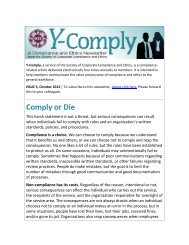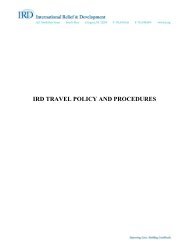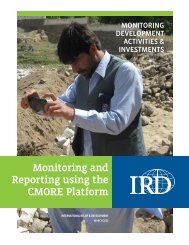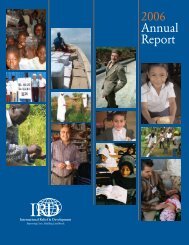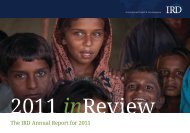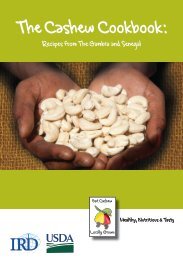Roof-Top Rainwater Harvesting Best Practices Guide - International ...
Roof-Top Rainwater Harvesting Best Practices Guide - International ...
Roof-Top Rainwater Harvesting Best Practices Guide - International ...
Create successful ePaper yourself
Turn your PDF publications into a flip-book with our unique Google optimized e-Paper software.
5 Replicability Factors<br />
The application of rainwater harvesting<br />
technologies varies widely, according to<br />
numerous factors which are context-specific.<br />
Factors enabling replicability of any roof-top RWH<br />
technology include the following:<br />
ɇɇ<br />
High degree of community involvement<br />
ɇɇ<br />
Locally available skills<br />
ɇɇ<br />
Cost<br />
ɇɇ<br />
Availability of materials<br />
ɇɇ<br />
Suitable climactic conditions<br />
ɇɇ<br />
Market/demand for additional tanks<br />
ɇɇ<br />
Resource mobilization from multiple<br />
stakeholders<br />
ɇɇ<br />
Training and demonstrations<br />
For project success and sustainability, proponents<br />
must consider these in the planning/inception<br />
stages.<br />
A key factor in ensuring sustainability of the<br />
roof-top RWH systems is community ownership.<br />
Projects teams must look for ways to extend<br />
the impact of the intervention, post project<br />
handover. Conducting a willingness-to-pay study<br />
is recommended to help establish the feasibility<br />
of the project, and the prospects for increasing<br />
the adoption of roof-top RWH as a water supply<br />
solution after project completion.<br />
Figure 7: Willingness-to-Pay Study<br />
ɇɇ<br />
A willingness-to-pay study, conducted by<br />
IRD Zimbabwe, concluded that 5% to 15% of<br />
Chitungwiza’s 300,000 homeowners are willing to<br />
pay more than $1,000 for a standard <strong>Roof</strong>-top RWH<br />
system, while up to 25% of the homeowners are<br />
willing to pay $500.<br />
ɇ ɇ This indicates the potential demand of 6,000 to<br />
18,000 <strong>Rainwater</strong> <strong>Harvesting</strong> Units equating to $6-8<br />
million in revenue for local businesses and local<br />
industry.<br />
Willingness-to-pay studies help projects to<br />
develop strategies for:<br />
ɇɇ<br />
Creating linkages with credit for homeowners<br />
to finance the systems, for example, through<br />
affordable payroll deductions. Through links<br />
to financial institutions, it is possible to create<br />
credit schemes for people to purchase an entire<br />
system and pay back over a period of time.<br />
ɇɇ<br />
Establishing the need for financial mechanisms<br />
to support the demand and income levels of<br />
interested households<br />
ɇɇ<br />
The need to demonstrate the market<br />
opportunity. Links with private sector<br />
<strong>Roof</strong>-<strong>Top</strong> <strong>Rainwater</strong> <strong>Harvesting</strong> <strong>Best</strong> <strong>Practices</strong> <strong>Guide</strong> 21



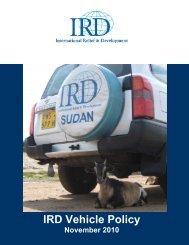
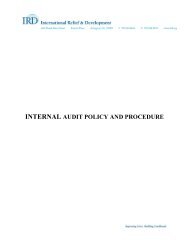
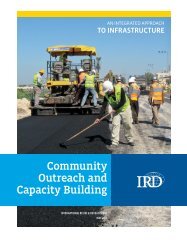
![Guide bonne pratique production d'oignon qualité_VF_4_2411012[1]](https://img.yumpu.com/23506639/1/184x260/guide-bonne-pratique-production-doignon-qualitac-vf-4-24110121.jpg?quality=85)

